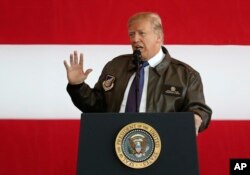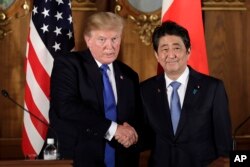During his stop in Tokyo this week, Japanese Prime Minister Shinzo Abe gave U.S. President Donald Trump a white hat that said: "Donald & Shinzo, Make Alliance Even Greater." And one way Abe is seeking to do that is by trying to get the United States to support a renewed Japanese push to promote its "Partnership for Quality Infrastructure" as an alternative to China's Belt and Road Initiative (BRI).
Analysts are closely watching if Japan's Prime Minister will succeed in his plans to enlist the U.S., Australia, and India in his program.
An important step will be a political decision, which is expected when officials of these countries meet on November 13-14 under the banner of US-Japan-India-Australia quadrilateral dialogue on the sidelines of the upcoming East Asia Summit in the Philippines. The four countries have revived the quadrilateral dialogue after a decade-long hiatus.
News of the dialogue has put Beijing on the defensive, with the Chinese foreign ministry expressing hope that the dialogue is not used for "targeting or damaging a third party's interest." And the new infrastructure competition has surfaced at a time when China's Communist Party took the unexpected step of enshrining the BRI in the party constitution.
Analysts said Japan may be echoing a concern which is widely shared by the three other countries, and to some extent by European countries, about many of the world's major infrastructure projects, like seaports and airports, being controlled by Chinese companies who try to win maintenance contracts after completing the construction work.
Providing choices
“Japan wants to ensure that countries have alternatives to Chinese-led infrastructure initiatives and that the regional economic architecture does not become excessively China-centric,” Andrew Small, a senior transatlantic fellow with the Asia Program of the German Marshall Fund told VOA.
“But aside from trying to ensure that the region does not become hard-wired to Chinese standards and Chinese firms, there is also a concern to avoid a situation in which countries’ economic dependence translates into undesirable political or security choices,” he said.
Nippon Export and Investment Insurance and the Japan Bank for International Cooperation will be signing a memorandum this week with the US-based Overseas Private Investment Corporation, to jointly finance projects in different sectors, including energy, according to Japan’s Nikkei Asian Review. The collaboration is looking closely at a solar project in Jordan which is being backed by Mitsui & Co., and U.S. energy provider AES.
“Japan has certainly doubled down on its engagement, particularly in Southeast Asia, but I think it is easy to forget that Japan has been building infrastructure in this region for quite some time,” said Jonathan Hillman, Director of Reconnecting Asia project at the Center for Strategic and International Studies.
“I see this partnership for quality infrastructure… as sort of, in part a response (from Japan) for belt and road, but it really is doubling down on what has been a historic commitment already,” he said.
Analysts have already noted that the fear of Chinese dominance in Asia is what prompted Abe to offer $24 billion in aid to the Philippines. The money will go partly go into infrastructure projects like building rapid transit, bridges, and improvements to a container port in the country’s third largest city, Cebu.
Some analysts think China is far ahead in the infrastructure game and Japan cannot offer much competition.
“Belt and Road (projects) are about picking up smaller, less developed countries first. Those countries are more likely to get into China's orbit than the U.S. and gravitate towards Japan's, I would imagine. So they should have some successes but I imagine they would pale in comparison to the Chinese effort,” said Andrew Polk, co-founder of research firm Trivium/China.
US role
Trump's Asian tour may throw up some indications about the extent to which the U.S. will go in backing the Japanese effort. American companies connected to the construction business have not had much of an opportunity to participate in China's BRI and might expect a piece of the action in Tokyo's plan.
“The US is in the process of thinking through its own plans to provide alternative offers to the BRI and that will require closer cooperation with the other major economic powers, most obviously Japan and the Europeans,” Hillman said.
What is delaying U.S. involvement is the fact that it has yet to readjust its trade strategy after its withdrawal from the Trans-Pacific Partnership and various internal debates to resolve its own financing streams, Hillman said. Several governments, including South Korea, India, Australia and the European Union, are also rethinking their connectivity agenda, he said.
China's commitment
An important question is whether China is worried about this move.
Discussing the quadrilateral dialogue, Lian Degui, a professor at Shanghai International Studies University, said in an article in state-controlled Global Times, "If the US, Japan, Australia, and India can coordinate and support infrastructure construction and economic development of Indo-Pacific countries, they are more than welcome. But if they try to incorporate values into economic issues and display prejudice and hostility toward other countries, they will not bring stability to the region.”
Beijing is expected to make an all-out bid to fight competition in the crucial area of infrastructure because the BRI is China's conduit for exporting surplus capacity in industries like steel and cement.
“Putting the Belt and Road in the party charter clearly underscores the intended longevity of the initiative,” Hillman said. “This does, however, raise the pressure on China to deliver."










